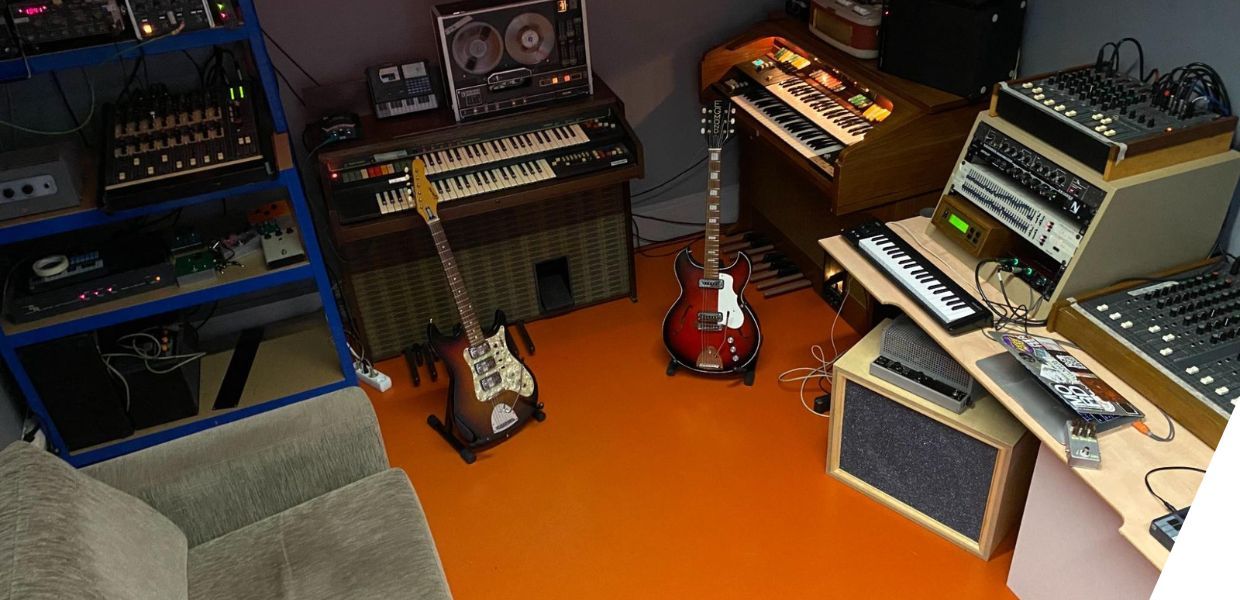Sound & Vision has long been known in the cultural heritage world as a leader in digital innovation, open access and promoting creative reuse. We have a team dedicated to working with makers to create new stories, artworks and narratives inspired by reusing the institute’s massive audiovisual collection.
A long-overlooked part of our collection, the physical collection, has finally found its way to the surface in a very simple, traditional form: a music studio. Inspired by the likes of fellow Dutch musical heritage advocates Willem Twee Studios in Den Bosch and the legacy of European musical exploration at audiovisual hubs like INA, RAI and the BBC and Philips’s NatLab, Studio RE:VIVE, is a freely accessible music studio where every instrument, microphone, tape recorder, noise box etc. was made or designed in The Netherlands.
Celebrating Dutch musical heritage
The Netherlands’ impact on the world of sound and music is immense. Philips, the Dutch electronics behemoth, was established in 1891 and for most of the 20th century dominated the global electronics market. Its major sound inventions, the cassette, invented in 1964 by Lou Ottens and the CD, collaboratively invented with Sony in 1982, changed the world and the way we listen to and share music. As Sound & Vision, it behooves us to share this story and celebrate this heritage.
For many countries, focusing solely on musical and audio equipment made in its own country would be tricky. But not for The Netherlands. British Rock and Roll? You can thank Bernard DH Tellegen and Gilles Holst at Philips, who invented the Pentode tube in 1926. The EL34 pentode tube powers the British amps used by Jimi Hendrix, The Who and nearly every other hard-rock band even to this day. To this day, vintage Philips (or Mullard, a UK subsidiary of Philips) EL34 tubes are highly prized and sought after for their quality and sound.
Perhaps one of the biggest rock bands to ever exist - U2 - in part owe their unique sound to the Netherlands, as Sangster and Teer invented Bucket Brigade Delay in 1969, again at Philips. In the simplest of terms, these little chips capture a bit of sound and repeat it again and again. When these chips found their way into ‘delay pedals’ and the hands of guitarists, a whole new world of sonic exploration opened up.
Looking past Philips, The Netherlands is well known for home organs that were both a spiritual and musical endeavor to bring the sound of the church into homes. While an eyesore to some today (they can regularly be found on online second hand stores), they’re beautiful pieces of analog engineering, packing an immense amount of sound and power. The most famous, the Eminent 310u, was even the first string synthesizer ever made. It went on to become better known as the Arp Solina String Ensemble and is featured on countless hit records from the late 70s and early 80s.
A sustainable approach
There’s plenty more to highlight in terms of equipment. However, what’s perhaps most important about Beeld & Geluid | Studio RE:VIVE is its focus on sustainability. As witnessed at EuropeanaTech 2023, cultural heritage is forging important, innovative new ground in terms of VR, 3D, acoustics, AI and more hypermodern technologies. While all these advancements have their place and significance, we sometimes forget the sheer environmental resources required to make them possible and maintain them. AI computing can use an immense amount of energy, and whether that comes from a green source or not, the fact remains that even the devices needed to run them all require precious limited resources.
VR and AR, while groundbreaking in what they bring to new forms of experiencing cultural heritage and accessibility, require specific equipment. Whether it be VR goggles or even a smartphone, these devices need to be relatively new as the instances require specific operational capacities. And again, these extra, necessary devices also require precious natural resources to manufacture and the sourcing of these materials is subject to extensive international human rights investigations.
Studio RE:VIVE’s is built on equipment that would otherwise be thrown away or left to deteriorate in an attic in support of the Netherlands goal of creating a circular economy by 2050. We work with an array of repair specialists who have the expertise to bring equipment that does need work back to life. The growing calls from governments to improve and encourage right-to-repair laws and repair cafes illustrates how important repairing as opposed to buying new is and will be moving forward. Yet an unfortunate reality is that this repair expertise is dying out and especially in The Netherlands, there is a growing shortage of trade workers who will be able to replace them. We hope to illustrate with the studio that even with unwanted and overlooked equipment, there resides a wealth of creative potential.
Find out more
All in all, Studio RE:VIVE is an experiment. We’re seeing what happens when we strip away the flash of modernity and its conveniences (working in this studio requires a lot of patience!). So far the response has been overwhelmingly positive, but perhaps the novelty will eventually die out and like much of the equipment in the studio, be left behind for the next new thing. But for now we’ll keep working at it. And you are welcome to visit!
To stay up to date with the latest developments in research and development in the cultural heritage sector, network with peers and collaborate, join the EuropeanaTech Community today!


